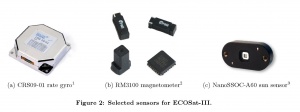An Accurate, Inexpensive Attitude Determination and Control System for CubeSats by Duarte Rondão, Cass Hussmann and Afzal Suleman Part 5
From The Space Library
Contents |
V. Sensors and Actuators
ECOSat-III will maintain the same suite of sensors ECOSat-II featured, albeit with different models. The sensor hardware consists of a three-axis rate gyroscope, a three-axis magnetometer and a two-axis sun sensor. The actuator hardware consists of the magnetorquers designed in-house for ECOSat-II, plus a specially designed RWS to improve attitude pointing accuracy.
Figure 2: Selected sensors for ECOSat-III.
Table 1: CRS09-01 characteristics.1
A. Rate Gyroscope
The selected rate gyroscope for ECOSat-III is the Silicon Sensing CRS09-01 MEMS gyroscope. It is displayed in Figure 2a. Its main characteristics are displayed in Table 1. It is one of the best commercially available MEMS gyros [16], selected from a trade-off with 3 others: the Systron Donner QRS116, the Honeywell HG1900 and the Analog Devices ADIS16135. Being commercial off-the-shelf (COTS) equipment, it costs only 900 USD. This price is beaten by the ADIS16135, which costs 200 USD less; however, the noise figures in the ADIS16135 were deemed too high for this application, making it impossible to achieve the mission requirements. The other gyros considered in the trade-study had prices in the order of thousands of dollars, which is very much above the ADCS budget. The CRS09-01 was thus deemed the best choice for quality with respect to price.
B. Three-Axis Magnetometer
The three-axis magnetometer used in this work is the PNI RM3100. It is displayed in Figure 2b. Its main characteristics are displayed in Table 2. The RM3100 is the successor of the discontinued MicroMag3, a magnetometer developed also by PNI which has a CubeSat flight legacy aboard the RAX-2 satellite, built by the University of Michigan, and the Aeneas CubeSat, built by the University of Southern California. Other magnetometers considered in the trade study have their cost in the order of hundreds of dollars; the RM3100 costs only 61 USD and has a similar performance to the other magnetometers considered.
1 http://www.siliconsensing.com/media/455035/CRS09-00-0100-132_1_PDF_SSS_-.pdf, accessed November 2015.
2 http://www.willow.co.uk/html/rm3100-geomagnetic-sensor.html, accessed November 2015.
3 http://www.solar-mems.com/smt_pdf/Brochure_NanoSSOC-A60.pdf, accessed November 2015.
Table 2: RM3100 characteristics.4
Table 3: NanoSSOC-A60 characteristics.5
C. Two-Axis Sun Sensor
The two-axis sun sensor considered in this work is the Solar MEMS Technologies NanoSSOC-A60 analog sun sensor for nano-satellites. It is displayed in Figure 2c. Its main characteristics are displayed in Table 3. Apart from less precise photocells and in-house developed sensors, the SSBV sun sensor is the typical choice for CubeSat sun sensing. However, Solar MEMS Techologies’ alternative NanoSSOC-A60 sensor costs 1000 USD less, with a similar accuracy and a wider field-of-view. The digital edition, NanoSSoc-D60, was also considered. However, it is 1500 USD more expensive than its analog counterpart. Adding a microcontroller with an ADC attached to the CAN bus to fit an analog sun sensor has essentially a negligible cost compared to the alternative.
D. Three-Axis Magnetorquer
ECOSat-III’s three-axis magnetorquer is constituted by six orthogonally-oriented magnetic torque rods, two per axis. An example of such a torque rod built in-house for the project is displayed in Figure 3a. The magnetorquer main characteristics are displayed in Table 4. These torque rods were designed for ECOSat-II and optimized for the lowest supply voltage that yields the highest possible magnetic dipole moment, considering the size constraints and power budget of the satellite, and deemed fit for use in ECOSat-III [17]. The torque core chosen for the design was the Nickel-Iron Alloy 50 which consists of roughly 50% iron and 50% nickel. This material was selected because of its is lightness and high permeability and saturation induction. The wire to be used will have to have proper insulation with good off-gassing properties, temperature tolerances and resistance to gamma radiation. So far, the type of insulation has been narrowed down to three choices: fluorinated ethylene propylene, polytetrafluoroethylene and crosslinked ethylene tetrafluoroethylene. All three are equally suitable for the task. The end decision will be based on cost and availability. There is not yet a cost estimate for the custom-built magnetorquers, but it is theorized that it will be negligible with respect to the total ADCS cost.
4 http://www.pnicorp.com/wp-content/uploads/RM3100-Datasheet_r5_11.pdf, accessed November 2015.
5 http://www.solar-mems.com/smt_pdf/Brochure_NanoSSOC-A60.pdf, accessed November 2015.
6 http://www.micromo.com/1202h006bh.html, accessed November 2015.
Figure 3: Selected actuators for ECOSat-III.
Table 4: Magnetorquer characteristics for individual rods. [17]
E. Three-Axis Reaction Wheel System
ECOSat-III will feature a specially designed RWS for precision pointing [18]. The designed flywheel is rendered in Figure 3b and the chosen motor is represented in Figure 3c. The RWS characteristics are displayed in Table 5. The RWS consists of four flywheels and motors configured in a pyramidal array. The optimal configuration was designed to minimize power consumption. It is able to generate a maximum torque of 8.3125 × 10−6 Nm and is targeted for a lifetime of two years.
Please continue to part 6 here






